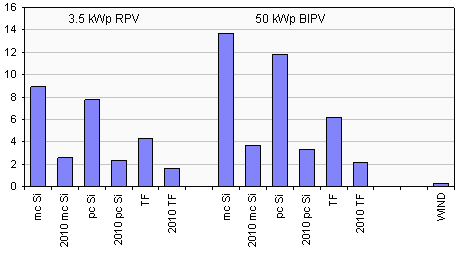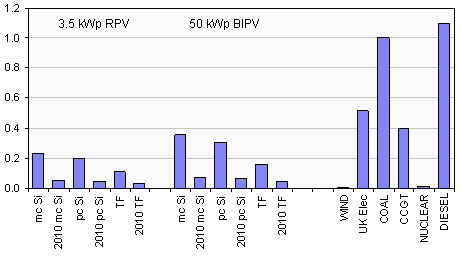








  |
| Environmental Life Cycle Assessment (LCA) | Conclusions |
A very general Environmental Life Cycle Assessment was carried out using Energy Payback Time (EPBT) and CO2 Emissions as environmental impact indicators. The EBPT gives an idea of the sustainability of an activity, in this case the construction and operation of a PV Power System. CO2 emissions are quite topical nowadays, and are becoming a reference for environmental impact assessment.
In order to calculate these indicators is necessary to account for all the energy used and the CO2 emissions produced, directly or indirectly in the manufacturing, operation and decommissioning of the systems. It is not easy to do so. We decided to rely on data from other studies, try to estimate reliable average values and concentrate in the analysis. In these calculations, a fuel mix with a 0.35 conversion efficiency from primary energy to electricity was considered to convert electricity requirements into primary energy needs. The CO2 emissions were considered to be 0.52 kg/kWh. System Lifetime was taken as 20 years for the present technology analysis and as 25 for the 2010. We consider these figures moderate, since some PV panel manufacturers already guarantee to keep 85% of the rated output in 25 years time. Two different cases were studied:
- Residential PV (RPV): 3.5 kWp system with a roof integrated 30 degree tilt array.
- Building Integrated PV (BIPV): 50 kW system with a facade integrated 90 degree tilt array.

Table. 2. Energy Payback Time and CO2 emissions of a 50 kW PIPV System

Energy Pay-Back Time

CO2 emissions

The tilt of the installation directly affects the Energy Payback Time and the specific CO2 emissions, as they would other parameters which affect the power output (inverter overall efficiency, panel orientation, shading, etc.).
Emissions are dominated by the energy use during PV production. Around 95 % of this energy is electricity. From this figure is important to realise that the environmental performance of PV power systems heavily depends on the energy efficiency of PV system manufacturing and on the performance of the energy system itself, electricity production in particular. The choice of energy conversion efficiency is very important when the manufacturing and the installation of modules are performed in different countries, due to difference in the electricity supply mix.
It is important to note that differences in data related to energy requirements in PV module manufacturing are very high between different sources and manufacturers. The figures used in this analysis are average values from data given by various authors in the "Environmental Aspects of Photovoltaic Power Systems" Workshop held in Utrecht, Netherlands, in Dec 1997.
|
|
Back To Top |
| Home | Overview | System Design | Grid Connection | Environment | Economics |
| Links | About Us |
© Copyright 1999 Bastarrika Kalantzis Zurutuza
Updated 12 April 1999